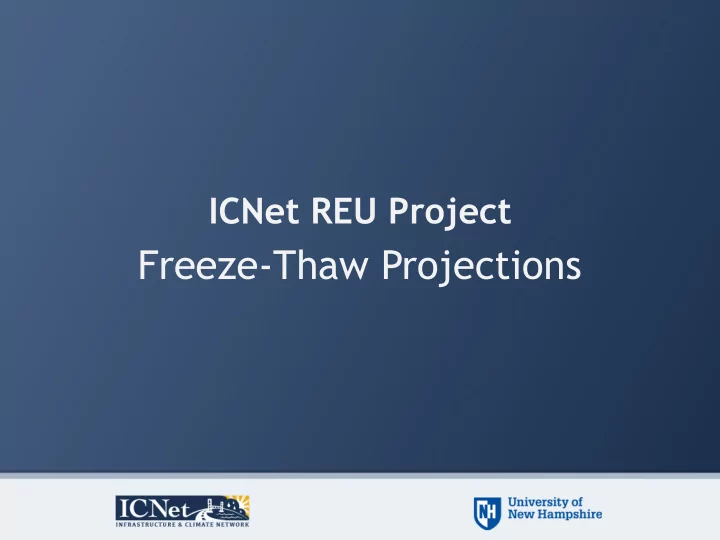

ICNet REU Project Freeze-Thaw Projections
Our Team Ashley Thomas Senior at the University of Massachusetts Dartmouth studying Civil Engineering Dr. Anne Stoner Postdoctoral researcher at the Texas Tech Climate Science Center PhD in Atmospheric Sciences and Meteorology Jill Crowley from the University of Illinois at Urbana- Junior at the University of New Champlain Hampshire studying Environmental Engineering Dr. Heather Miller Professor at UMass Dartmouth, Civil Engineer at Ashley Filion LaBella Associates, D.P .C. Junior at the University of New PhD in Civil Engineering from the University of New Hampshire Hampshire studying Civil Engineering Dr. Jennifer Jacobs Professor at the University of New Hampshire Tova Levin researching climate change, water resources, and infrastructure. Sophomore at Boston University PhD in Civil Engineering from Cornell University studying International relations and Environmental Policy Dr. Jo Sias Daniel Professor at the University of New Hampshire researching asphalt concrete, the performance of flexible pavements, recycled materials, and the Masoumeh Khalkhali impacts of climate change on pavement. PhD student PhD in Civil Engineering from North Carolina State University
Motivation The climate is changing. How will it impact us? Roadways (DOT) Big Picture Not much research has been done The changing climate affects the involving direct impact of climate freeze/thaw seasons change on infrastructure Freezing/thawing seasons affects the What’s the best way to tackle strength of low volume roads climate change research? (framework) DOT implements restrictions and premiums for roadways How will those change?
Freeze-Thaw Background & Indicators WWP SLR • Winter Weight Premium Spring Load Restrictions • • Water in pavement freezes • Pavement layers thaw starting at the top = extra strength • Water can’t escape through • DOT allows transportation of heavy frozen layers below loads (Logging industry) = weaker • DOT implements weight Thawed soil; Excess moisture restrictions to prevent damage can’t drain down through underlying frozen layer * Frozen Soil
Our Process 1. Baseline analysis 2. Future Analysis • Use useful models to determine 9-10 models • how freeze/thaw indicators will 2 emission scenarios • change in the future Compare model output to • • New strategy for implementing observed WWP and SLR each year? Use avg. temp data • (1950-1999) from models 3. Document, Archive, & Compute cumulative freeze/ • Communicate thaw indices Which models can we keep? • • Record process & challenges • Relay lessons & strategies to others Q: Input specifically on approach to baseline comparisons?
Climate Model Output Source for Daily Temp: Bureau of Reclamations Q: Opinions/suggestions about data collection, practices, timelines, etc.?
Choosing Models CMIP5 Model Ranking Developed By Anne Stoner and Katharine Hayhoe Grouping System: 1: Most Reliable – updated, well-documented, long established 2: New and Interesting – combine traditional components of climate models w/ other models 3. Experimental – brand new global climate models Q: Suggestions for a better approach to model selection?
Models and Emissions Scenarios
Data Analysis Avg. Daily Temps. • ! TI T T = − i avg , i ref • Cumulative Freeze/Thaw n CTI n = ∑ ( Daily Thawing Index – 0.5 × Daily Freezing Index ) Indices i 1 = WWP when CFI > 280 SLR when CTI > 25 ! 600 FI T T = − i ref avg , i 500 n CFI FI ! ∑ 400 = n i CFI ( o F-days) i 1 300 = 200 100 0
Is the model in or out? Goal: Use baseline analysis to determine if climate models have gross errors Comparisons with: Box plots Histograms t-tests à Knock out crazy models Q: Advice for getting rid of models? Stupid things people have done?
Mariaville, ME: Model BCC-CSM1-1
Discussion Do you have any advice or input on research process thus far? • Constructive criticism? • Room for learning and growth? • Other sectors we can learn from? •
Recommend
More recommend